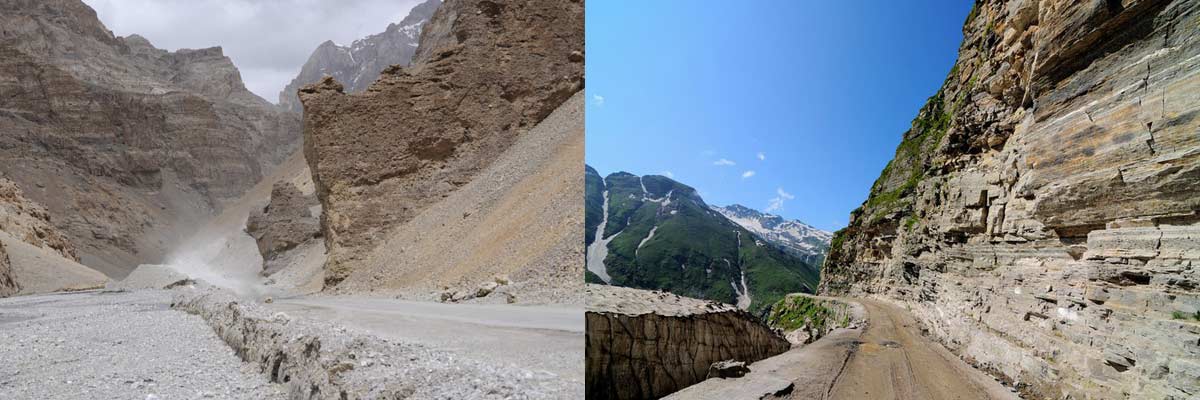
Must Visit Places of intrest Arround Leh Ladakh
Shanti Stupa Leh:-
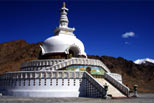 Shanti Stupa in Ladakh is a Buddhist Monastery located in the Changspa area of Ladakh. Shanti Stupa was built around 25 years ago by the Japanese Buddhist Organization namely Japanese for World Peace. The aim behind constructing the Shanti Stupa Monastery in Ladakh was to celebrate the completion of 2500 years of Buddhism. The inauguration of the Shanti Stupa was done by none other than his holiness, Dalai Lama himself. One of the newest of Leh’s religious monument, Shanti Stupa was built by a Japanese Buddhist order in 1985.Shanti Stupa offers fantastic views of Leh city.
Shanti Stupa in Ladakh is a Buddhist Monastery located in the Changspa area of Ladakh. Shanti Stupa was built around 25 years ago by the Japanese Buddhist Organization namely Japanese for World Peace. The aim behind constructing the Shanti Stupa Monastery in Ladakh was to celebrate the completion of 2500 years of Buddhism. The inauguration of the Shanti Stupa was done by none other than his holiness, Dalai Lama himself. One of the newest of Leh’s religious monument, Shanti Stupa was built by a Japanese Buddhist order in 1985.Shanti Stupa offers fantastic views of Leh city.
Highlights: Offers panoramic views of Leh and the surrounding mountains.
Activities: Visiting the stupa, meditating, and enjoying the peaceful ambiance.
Best Time to Visit: Anytime during the tourist season, but early mornings offer a serene atmosphere.
Leh Palace:-
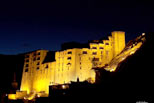 Leh Palace of Ladakh, though in a dilapidated condition continues to lure tourists from far and wide. Located in the Himalayas, the adventurous journey one has to undertake to reach the palace is what makes it even more special. Leh palace was built in the 17th century by King Singe Namgyal as the royal residence.
Leh Palace of Ladakh, though in a dilapidated condition continues to lure tourists from far and wide. Located in the Himalayas, the adventurous journey one has to undertake to reach the palace is what makes it even more special. Leh palace was built in the 17th century by King Singe Namgyal as the royal residence.Location: In the heart of Leh, built in the 17th century by King Sengge Namgyal.
Highlights: Offers panoramic views of Leh and the surrounding mountains. The palace now houses a museum and a prayer room.
Activities: Exploring the museum, enjoying the views from the rooftop, and learning about Ladakhi history.
Best Time to Visit: Anytime during the tourist season, but early mornings or late afternoons offer the best views.
Thiksey Gompa:
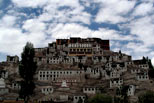 Thiksey Gompa of Ladakh is situated at a distance of approximately 18 km from the town of Leh. One of the most beautiful monasteries of Ladakh, it belongs to the Gelukpa Order of Buddhism. Sherab Zangpo of Stod got the Thikse Monastery built for the first time, at Stakmo. However, later Spon Paldan Sherab, the nephew of Sherab Zangpo, reconstructed the monastery in the year 1430 AD. The new monastery was sited on a hilltop, to the north of Indus River.
Thiksey Gompa of Ladakh is situated at a distance of approximately 18 km from the town of Leh. One of the most beautiful monasteries of Ladakh, it belongs to the Gelukpa Order of Buddhism. Sherab Zangpo of Stod got the Thikse Monastery built for the first time, at Stakmo. However, later Spon Paldan Sherab, the nephew of Sherab Zangpo, reconstructed the monastery in the year 1430 AD. The new monastery was sited on a hilltop, to the north of Indus River. Location: About 19 km from Leh, one of the largest monasteries in Ladakh.
Highlights: Known for its impressive architecture and spiritual significance.
Activities: Exploring the monastery, attending prayer sessions, and learning about Tibetan Buddhism.
Best Time to Visit: Anytime during the tourist season, but early mornings offer a peaceful atmosphere.
Alchi Village:-
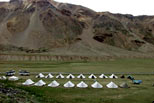 Alchi is a village and monastery in the leh.city ofladakh region of J & k situated on the bank of Indus river 70 km downstream from the capital in leh . Unlike the other gompas in Ladakh, Alchi is situated on lowland, not on a hilltop. he village is famous for the existence of one of the oldest monasteries in Ladakh (a national heritage) Alchi Monastery, mainly known for its magnificent, and well-preserved 11th or 12th century wall paintings, all in an Indian style. Alchi is a small village with all modern facilities for overnight stays, Alchi is a comfortable and a nice place in the heart of the Himalayas. The best time to visit is from June to September.
Alchi is a village and monastery in the leh.city ofladakh region of J & k situated on the bank of Indus river 70 km downstream from the capital in leh . Unlike the other gompas in Ladakh, Alchi is situated on lowland, not on a hilltop. he village is famous for the existence of one of the oldest monasteries in Ladakh (a national heritage) Alchi Monastery, mainly known for its magnificent, and well-preserved 11th or 12th century wall paintings, all in an Indian style. Alchi is a small village with all modern facilities for overnight stays, Alchi is a comfortable and a nice place in the heart of the Himalayas. The best time to visit is from June to September.
Location: One of the oldest monasteries in Ladakh, known for its ancient paintings and carvings.
Highlights: Offers a glimpse into Ladakh's rich cultural heritage and artistic traditions.
Activities: Exploring the monastery, admiring the ancient art, and learning about Ladakhi culture.
Best Time to Visit: Anytime during the tourist season, but early mornings offer a peaceful atmosphere.
Khardung-La Pass:-
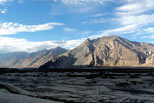 Khardung-la Pass (5359m) is alleged to be the highest mountain pass in Ladakh. It is almost always covered in fog and snow, and it boasts of being one of the highest motorable roads in the world. It is the gateway to Shyok and Nubra valleys and is situated 37 kms north of Leh. This short route of 37 kms takes about 2 hours to cover. The first 24 km from Leh to South Pullu check point are paved. From South Pullu to North Pullu check point, beyond the pass, the road is narrow and broken, being as it were, made up of loose rock, dirt, and occasional rivulets of snow melt. The pass was built in 1976 and was opened to motor vehicles in 1988. It has seen many automobile, motorbike and mountain biking expeditions. Earlier it was considered one of the most important passes for trade in the Central Asia. Khardung La was the last major blockage to caravans on way to the Indus valley. Even today it is very valuable for the Indian Army.
Khardung-la Pass (5359m) is alleged to be the highest mountain pass in Ladakh. It is almost always covered in fog and snow, and it boasts of being one of the highest motorable roads in the world. It is the gateway to Shyok and Nubra valleys and is situated 37 kms north of Leh. This short route of 37 kms takes about 2 hours to cover. The first 24 km from Leh to South Pullu check point are paved. From South Pullu to North Pullu check point, beyond the pass, the road is narrow and broken, being as it were, made up of loose rock, dirt, and occasional rivulets of snow melt. The pass was built in 1976 and was opened to motor vehicles in 1988. It has seen many automobile, motorbike and mountain biking expeditions. Earlier it was considered one of the most important passes for trade in the Central Asia. Khardung La was the last major blockage to caravans on way to the Indus valley. Even today it is very valuable for the Indian Army.
Location: The highest motorable road in India, at an elevation of 5,602 meters.
Highlights: Offers breathtaking views of the snow-clad peaks of the Zanskar and Karakoram ranges.
Activities: Driving through the pass, enjoying the views, and taking photos.
Best Time to Visit: May to September for clear roads and accessible pass.
Pangong Lake:-
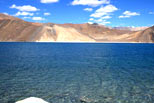
Geography and Location
Location: Pangong Lake, also known as Pangong Tso, is situated in the Himalayas, approximately 170 kilometers from Leh, Ladakh.Altitude: The lake is located at an elevation of about 4,350 meters (14,270 feet).
Length: Pangong Lake is approximately 134 kilometers long, stretching from India to China.
Area: The lake covers an area of about 604 square kilometers.
Unique Features
High Salinity: Despite its high salinity, Pangong Lake freezes completely during the winter months.Changing Colors: The lake is known for its mesmerizing colors, which change from shades of blue to green to grey throughout the day.
Biodiversity: The lake is a breeding ground for several species of migratory birds, including the bar-headed goose and Brahminy ducks.
Attractions
Scenic Beauty: The crystal-clear waters and the surrounding snow-capped mountains make Pangong Lake a breathtaking sight.Camping: Enjoy camping by the lake under the starry sky.
Photography: The ever-changing colors of the lake and the stunning landscape make it a photographer's paradise.
Bird Watching: Spot various species of birds that visit the lake, especially during the summer months.
Movies: Pangong Lake gained international fame after being featured in the Bollywood movie "3 Idiots."
Best Time to Visit
Season: The best time to visit Pangong Lake is from May to September when the weather is pleasant, and the lake is accessible.How to Reach
By Road: The lake can be reached via a 5-6 hour drive from Leh, passing through Chang La Pass (the third highest motorable road in the world).Permits: An Inner Line Permit (ILP) is required for Indian nationals to visit the lake. Foreign tourists need a Protected Area Permit (PAP).
Accommodation
Options: Various camping sites, eco-resorts, and homestays are available near the lake.Amenities: Basic amenities are provided, but it's advisable to carry essentials like warm clothing and toiletries.
Food
Local Cuisine: Enjoy local Ladakhi dishes like thukpa (noodle soup), momos (dumplings), and butter tea at nearby campsites and homestays.Connectivity
Mobile Network: BSNL provides limited network connectivity in the region. However, the signal can be weak and unreliable.Internet: Internet services are limited, mainly available in Leh.
Essential Tips
Acclimatization: Spend a day or two in Leh to acclimatize to the high altitude before heading to Pangong Lake.Packing: Carry warm clothing, even in summer, as temperatures can drop significantly at night. Don't forget essentials like sunscreen, sunglasses, and a first-aid kit.
Turtuk Village:-
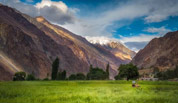 Turtuk Village is a hidden gem in the Nubra Valley of Ladakh, located near the Line of Control between India and Pakistan. Here are some details about Turtuk Village:
Turtuk Village is a hidden gem in the Nubra Valley of Ladakh, located near the Line of Control between India and Pakistan. Here are some details about Turtuk Village:
Geography and Location
Location: Turtuk is situated in the Nubra tehsil of the Leh district, on the banks of the Shyok River.Distance: It is approximately 205 kilometers from Leh.
Altitude: The village is nestled between the Karakoram and Himalayan ranges.
Historical Significance
Historical Background: Turtuk was under Pakistani control until 1971, and it has a fascinating history.Cultural Heritage: The village is one of the few Balti-populated areas in India.
Attractions
Natural Beauty: The village offers stunning views of the surrounding mountains and the Shyok River.Cultural Sites: Visit the Balti Heritage Home and Museum, and the Turtuk Gompa.
Historical Ruins: Explore the ruins of the Brokpa Fort.
Adventure Activities
Trekking: There are several trekking routes around the village.Mountain Biking: Enjoy mountain biking through the scenic landscapes.
River Rafting: Experience river rafting on the Shyok River.
Rock Climbing: Try rock climbing in the surrounding mountains.
Camping: Camp under the stars in the serene surroundings.
Permits
Protected Area Permit (PAP): A PAP is mandatory for visiting Turtuk due to its sensitive location.Best Time to Visit
Season: The best time to visit Turtuk is from April to September when the weather is pleasant.How to Reach
By Air: The nearest airport is Kushok Bakula Rimpochee Airport in Leh, about 205 kilometers away.By Road: You can hire a taxi from Leh to reach Turtuk. The journey takes approximately 6-8 hours.
By Train: The closest railway stations are Kalka and Jammu Tawi. From there, you can take a bus or shared taxi to Leh and then proceed to Turtuk.
Accommodation
Options: Turtuk offers various homestays, guest houses, and campsites.Amenities: These accommodations are equipped with modern amenities.
Food
Local Cuisine: Enjoy traditional Balti dishes like apricot pancakes, yak butter tea, and locally-made bread.Connectivity
Mobile Network: BSNL and Airtel provide network connectivity in Leh, but only BSNL works in Turtuk.Internet: Internet services are limited outside Leh.
Turtuk Village is a unique destination that offers a blend of natural beauty, cultural heritage, and adventure activities.
Nurba Valley:-
 The Nubra Valley, once on the trading route that connected eastern Tibet with Turkistan via the famous Karakoram Pass, is the most recently opened area of Ladakh. Nubra invites you to a trip back in time into a nearly forgotten 'Shangri La'. With breathtaking views and delightfully hospitable inhabitants, it is quite an experience Known as the Valley of Flowers, Nubra is situated 150 kms north of Leh, and is the most fertile valley in Ladakh.. Its gentle slopes transform into a verdant green in the summer months, hence its name (Nubra means green). It is dominated by two expansive flood plains through which run the Nubra and Shyok rivers. The glaciers in the area provide abundant water till the end of autumn and the terraced fields are rich in alluvial brought by the two rivers.. The Shyok and Nubra rivers converge just above Deskit, is the largest town of Nubra Valley. Its population is predominantly Buddhis
The Nubra Valley, once on the trading route that connected eastern Tibet with Turkistan via the famous Karakoram Pass, is the most recently opened area of Ladakh. Nubra invites you to a trip back in time into a nearly forgotten 'Shangri La'. With breathtaking views and delightfully hospitable inhabitants, it is quite an experience Known as the Valley of Flowers, Nubra is situated 150 kms north of Leh, and is the most fertile valley in Ladakh.. Its gentle slopes transform into a verdant green in the summer months, hence its name (Nubra means green). It is dominated by two expansive flood plains through which run the Nubra and Shyok rivers. The glaciers in the area provide abundant water till the end of autumn and the terraced fields are rich in alluvial brought by the two rivers.. The Shyok and Nubra rivers converge just above Deskit, is the largest town of Nubra Valley. Its population is predominantly BuddhisNubra Valley is a magical place!
The “Valley of Flowers” nickname makes perfect sense given its vibrant, diverse landscape that stands in contrast to its arid desert surroundings. Here are some additional details and tips to complement the information you’ve shared:Geography and Location
Proximity to Leh: Since Nubra Valley is 120 kilometers north of Leh, it's often a part of road trips that explore more remote parts of Ladakh, including Pangong Lake and Tso Moriri.Strategic Importance: The valley is not only scenic but also strategically important due to its proximity to the Siachen Glacier (the highest battleground on Earth).
Key Attractions in More Detail
Diskit Monastery: Besides the massive Maitreya Buddha statue, this monastery offers incredible views of the valley below and is one of the oldest monasteries in Nubra, dating back to the 14th century. The monastery’s serene atmosphere and its Tibetan Buddhist architecture make it a peaceful stop.Hunder Sand Dunes: Riding the Bactrian camels (double-humped camels) across the sand dunes feels like a scene from a desert safari. The contrast of the barren dunes with the snowy peaks in the distance is one of Nubra Valley’s signature sights.
Panamik Village: The hot springs here are quite popular, believed to have therapeutic properties due to the sulfur content. They offer a great way to unwind after a long trek or day of sightseeing.
Turtuk Village: Turtuk, on the border with Pakistan, is unique for its Balti culture and is the last village on the Nubra side that one can visit without restrictions. It's a remote, stunning spot, especially during the summer when the apricot orchards are in bloom.
Zamskhang Palace: While in ruins, this historical palace offers a glimpse into the region's former grandeur, making it an intriguing stop for history enthusiasts.
Best Time to Visit
Summer Season (May to August): This is indeed the best time to visit Nubra Valley as the weather is mild and all major attractions are accessible. During this time, the temperature can range from 15°C to 25°C (59°F to 77°F), making it perfect for outdoor activities.Autumn (September to October): Visiting during autumn can offer a quieter experience, and the valley is painted with rich fall colors, creating breathtaking landscapes.
Winter (November to February): While winter offers a more serene, peaceful atmosphere, the region becomes isolated with snow and freezing temperatures, so it’s typically not recommended for first-time visitors.
Activities
Trekking: Besides Yarab Tso Lake, Nubra Valley offers several other trekking opportunities. One popular route is the Trekking to the Siachen Glacier Base Camp, which is a challenging but rewarding adventure, for those interested in exploring one of the world’s highest battlefronts.Camping: Turtuk and the nearby areas like Sumur are fantastic for camping. The starry nights in Nubra are among the clearest, offering spectacular stargazing opportunities.
Shopping and Local Crafts: As you mentioned, Nubra is great for picking up Kashmiri and Tibetan handicrafts, particularly Pashmina shawls and apricots, which are famous in the region. Almonds from the valley are also highly prized, and you can find many local stalls offering them.
Travel Tips
Inner Line Permit: Yes, it’s essential to get an Inner Line Permit (ILP) for visiting Nubra, especially since it's a sensitive border region. These permits are easily available in Leh and are typically valid for a few days.
Acclimatization: Since Nubra Valley is at a high altitude, travelers should spend a day or two acclimatizing in Leh before heading to the valley. Altitude sickness can affect some visitors, so it’s important to stay hydrated, avoid over-exertion, and give your body time to adjust.
Accommodation: Accommodation ranges from basic homestays to more comfortable guesthouses. In places like Hunder, you may also find luxurious desert camps, offering a glamping experience.
Traveling Around
Road Travel: The Khardung La Pass, which is considered one of the highest motorable roads in the world, is the main route to reach Nubra Valley from Leh. The road is breathtaking but can be quite rough, so it's essential to be prepared for high-altitude driving.Local Transport: If you’re not self-driving, shared taxis or private jeeps are available for hire in Leh to take you on a tour around Nubra Valley. However, pre-booking transportation is advisable, especially during the peak tourist season.
Cultural Experience
Nubra Valley offers an amazing chance to experience Ladakhi culture up close. The villages are peaceful and reflect the traditional way of life, especially in areas like Sumur and Panamik. You may be invited to a local home for tea or to see the process of traditional carpet weaving or butter tea preparation.Nubra Valley is truly a gem of Ladakh, offering a mix of natural beauty, cultural heritage, and adventure.
Tso Moriri Lake:-
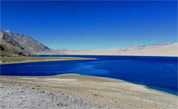 Tso Moriri is a stunning high-altitude lake located in the Ladakh region of India, specifically within the Changthang Plateau. It's situated at an elevation of about 4,595 meters (15,075 feet) above sea level, making it one of the highest lakes in the world. The lake spans an area of around 120 square kilometers and is surrounded by snow-capped mountains, offering a breathtaking view.
Tso Moriri is a stunning high-altitude lake located in the Ladakh region of India, specifically within the Changthang Plateau. It's situated at an elevation of about 4,595 meters (15,075 feet) above sea level, making it one of the highest lakes in the world. The lake spans an area of around 120 square kilometers and is surrounded by snow-capped mountains, offering a breathtaking view.Tso Moriri is known for its clear turquoise waters, which are fed by glacial streams. It’s a remote and peaceful place, and the area is also a wildlife sanctuary, home to species like the Tibetan wild ass (kiang), marmots, and migratory birds. The lake is part of the Karakoram Range, and its surroundings are largely untouched, making it a fantastic destination for nature lovers, trekkers, and those seeking tranquility.
It's also considered sacred by the locals and is a significant spot for Tibetan Buddhists, who often visit to pay respects and make offerings. The region's beauty is often compared to that of Pangong Lake, though it tends to be less crowded, providing a more serene experience.
Tso Moriri Lake is a mesmerizing and remote destination in the northernmost part of India, nestled in the Ladakh region, specifically within the Changthang Plateau. Here’s a detailed overview:
Location and Geography
Altitude: 4,595 meters (15,075 feet) above sea level.Area: Approximately 120 square kilometers.
Length: About 19 kilometers (12 miles) in length and 8 kilometers (5 miles) in width at its widest point.
Surroundings: The lake is surrounded by snow-capped mountains, arid terrain, and a range of unique wildlife. The region is part of the larger Tibetan Plateau.
Origin and Water Sources
Water Source: Tso Moriri is primarily fed by glacial meltwater, which helps maintain its clear turquoise-blue color.Salinity: The lake is considered a closed basin, which means water doesn’t flow out to the sea. However, due to the limited inflow of water and evaporation, the lake’s salinity is relatively low compared to other saltwater lakes.
Ecological Importance
Wildlife Sanctuary: Tso Moriri is part of the Tso Moriri Wetland Conservation Reserve, which is a protected area. The sanctuary supports a variety of wildlife, including:Tibetan Wild Ass (Kiang): A rare and endangered species of wild ass.
Marmots: These creatures are commonly found in the region.
Birdlife: The lake attracts migratory birds like the bar-headed goose, brown-headed gull, and more. It’s a significant site for birdwatchers.
Flora and Fauna: The surrounding region, though arid, has patches of alpine vegetation, which includes grasses and shrubs. The plateau is home to herders who raise yaks and sheep.
Cultural and Spiritual Significance
Tibetan Buddhist Influence: Tso Moriri is revered by local Tibetans and Buddhists. It holds spiritual significance, and several monasteries and small shrines are found around the lake.Nomadic Herders: The Changpa, a nomadic tribe in Ladakh, reside in the region and rely on the lake’s waters for their livestock, including yaks, sheep, and goats. They often travel with their herds to graze in the surrounding grasslands.
Tourism and Accessibility
Remote Location: Due to its high altitude and remoteness, Tso Moriri is less touristy compared to the more popular Pangong Lake. However, it has increasingly gained attention for its raw beauty and serene surroundings.Best Time to Visit: The best time to visit Tso Moriri is during the summer months, from June to September, as the weather is more hospitable and the roads are accessible. Winters are harsh, with temperatures plummeting below freezing.
Accessibility: The lake can be reached from Leh, the capital of Ladakh. The drive typically takes about 7–8 hours from Leh, covering a distance of 240 kilometers (150 miles). Travelers must pass through the villages of Chumathang and Mahe, and permits are required for visiting certain areas, as they fall under protected zones near the Indo-China border.
Accommodation: There are a few basic guesthouses and homestays in the nearby villages of Karzok, the main settlement near Tso Moriri. Camping by the lake is also popular for those seeking a more adventurous experience.
Activities
Trekking: The lake offers opportunities for trekking in the surrounding hills, allowing visitors to take in panoramic views of the lake and the surrounding landscape. You can also trek along the lake’s periphery, observing the local wildlife.Photography: The area is a photographer’s paradise, with its dramatic landscapes, wildlife, and stunning vistas. The clear blue waters of Tso Moriri against the backdrop of towering peaks provide incredible photo opportunities.
Bird Watching: The lake is a key stop for migratory birds, especially during the migratory season. Birdwatchers flock to the area to spot several unique species.
Permits and Travel Tips
Inner Line Permit (ILP): Foreign nationals need an Inner Line Permit (ILP) to visit the lake, as it lies in a border area. Indian citizens may need a permit as well, depending on the exact route taken.Health Precautions: Since Tso Moriri is at a high altitude, acclimatization is essential to avoid altitude sickness. Visitors should spend a couple of days in Leh before heading to the lake to help adjust to the altitude.
Weather Considerations: The weather can be unpredictable. Even in summer, the temperatures can drop sharply in the evening. Carry warm clothing and be prepared for sudden weather changes.
Nearby Attractions
Mahe Bridge: A beautiful spot on the way to Tso Moriri, known for its picturesque location.Chumathang: A village famous for its hot springs, located en route to Tso Moriri.
Korzok Monastery: Situated on the banks of the lake, this Buddhist monastery is a peaceful and scenic spot, offering spiritual solace and stunning views of the lake.
Challenges and Considerations Limited Facilities: Due to its remote location, facilities around Tso Moriri are basic. Travelers need to carry their own supplies like food, water, and other essentials.
Weather and Roads: The roads leading to the lake can be difficult to navigate due to the high altitude and unpredictable weather. They are mostly unpaved, and landslides can occasionally block roads during monsoon season.


